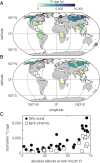Climate control on terrestrial biospheric carbon turnover
- PMID: 33593902
- PMCID: PMC7923348
- DOI: 10.1073/pnas.2011585118
Climate control on terrestrial biospheric carbon turnover
Abstract
Terrestrial vegetation and soils hold three times more carbon than the atmosphere. Much debate concerns how anthropogenic activity will perturb these surface reservoirs, potentially exacerbating ongoing changes to the climate system. Uncertainties specifically persist in extrapolating point-source observations to ecosystem-scale budgets and fluxes, which require consideration of vertical and lateral processes on multiple temporal and spatial scales. To explore controls on organic carbon (OC) turnover at the river basin scale, we present radiocarbon (14C) ages on two groups of molecular tracers of plant-derived carbon-leaf-wax lipids and lignin phenols-from a globally distributed suite of rivers. We find significant negative relationships between the 14C age of these biomarkers and mean annual temperature and precipitation. Moreover, riverine biospheric-carbon ages scale proportionally with basin-wide soil carbon turnover times and soil 14C ages, implicating OC cycling within soils as a primary control on exported biomarker ages and revealing a broad distribution of soil OC reactivities. The ubiquitous occurrence of a long-lived soil OC pool suggests soil OC is globally vulnerable to perturbations by future temperature and precipitation increase. Scaling of riverine biospheric-carbon ages with soil OC turnover shows the former can constrain the sensitivity of carbon dynamics to environmental controls on broad spatial scales. Extracting this information from fluvially dominated sedimentary sequences may inform past variations in soil OC turnover in response to anthropogenic and/or climate perturbations. In turn, monitoring riverine OC composition may help detect future climate-change-induced perturbations of soil OC turnover and stocks.
Keywords: carbon cycle; carbon turnover times; fluvial carbon; plant biomarkers; radiocarbon.
Copyright © 2021 the Author(s). Published by PNAS.
Conflict of interest statement
The authors declare no competing interest.
Figures




References
-
- Friedlingstein P., et al. ., Global carbon budget 2019. Earth Syst. Sci. Data 11, 1783–1838 (2019).
-
- Sulman B. N., et al. ., Multiple models and experiments underscore large uncertainty in soil carbon dynamics. Biogeochem. 141, 109–123 (2018).
-
- Jones C., et al. ., Twenty-first-century compatible CO2 emissions and airborne fraction simulated by CMIP5 earth system models under four representative concentration pathways. J. Clim. 26, 4398–4413 (2013).
-
- Carvalhais N., et al. ., Global covariation of carbon turnover times with climate in terrestrial ecosystems. Nature 514, 213–217 (2014). - PubMed
Publication types
MeSH terms
Substances
LinkOut - more resources
Full Text Sources
Other Literature Sources
Miscellaneous

